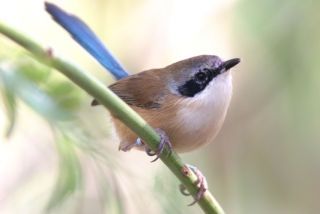Spider Wasp Bite
Yesterday, while searching for fairy-wrens along the Adcock River, I suddenly felt something big crawling up my pant leg. Assuming an ant, I swiped it out – but then the thing flew off, and it turned into a very large, beetle-like bug with long, bright orange antennae. It bit me a couple times on the way out, but no big deal – just a little sting.
At least, until today. My left knee has swollen to twice its normal size! I showed it to Steve, who told me a story of a lady who needed a skin graft after getting bit by some virulent beetle around here. That wasn’t too encouraging, so I typed “australian black beetle with orange antennae” into Google Images. Amazing what you can find out these days – turned out to be something called a Spider Wasp, which attacks spiders larger than itself (but not, apparently, a bug that kills people). Just a regular old wasp bite. Anyway, it’s itchy!


So, what’s the purpose of them molting into a “breeding” plumage when they breed in the winter, when their not in “breeding” plumage, as well as in the summer when they are? Normally, the “breeding” plumage is to attract a mate, the brighter the coloring the more attractive to a mate. If the males can attract females during the winter without their “breeding” plumage, then why spend the energy to molt into a bright “breeding” plumage?
Your wasp encounter sounds similar to the large tarantula hawk spider wasp (Pepsis formosa) I used to encounter on occasion while living in the Mojave desert. Supposedly fairly docile but still intimidating at close quarters with a body to 50mm and a stinger up to 9mm. Its sting rates near the top on the Schmidt Sting Pain Index. But yet a fascinating wasp to add some drama to any walk. I never found it to be aggressive.
Great blog Noah. I thoroughly enjoy both your posts and photo’s from down under………
que bonito!!! cuánto tiempo más estarás en Australia?
Tengo un mes mas en Australia. Voy a correr un marathon (42 kilometros) en mi ultimo dia, 15 Aug, antes de volver a Oregon…
Hey John – yeah, well, the swelling went down after a couple days so no big deal, but definitely an odd encounter. Glad you’re enjoying it!
Hey Tom – Well, things are a bit weird this year. We had an extremely dry wet season followed by a relatively wet dry season so far (if you can follow that!). Normally the fairy-wrens don’t breed in winter, but, this year, rain has set them off – they can nest any time of year if conditions are right. The purple color normally coincides with nesting and probably indicates males with better ability to breed – for instance, a recent nest where the male lacked purple turned out to have three infertile eggs, probably because he wasn’t quite up to it even though the female was keen.
voy para allá el año próximo! me voy a alemania en octubre =) y tengo que ir un semestre a new zeland……
suerte en el maratón, estaré al pendiente de tu resultado, a entrenar muchoooo